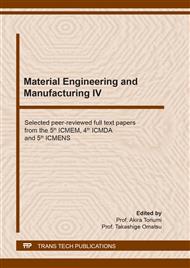p.94
p.103
p.109
p.116
p.125
p.133
p.139
p.145
p.151
Value-Added Utilization of Banana Peel (Musa acuminata): Adsorption Fatty Acid and Extending the Life of Activated Carbon
Abstract:
Cooking oil saturation due to frequent use for frying will result in a higher fatty acid content. Activated carbon made from the banana peel (Musa acuminata) with micro-mesoporous specifications can absorb free fatty acids. Banana peels are pyrolyzed into charcoal then activated alkaline at a temperature of 650°C. Then the activated carbon is washed and mashed to obtain activated carbon powder as an adsorbent by batch. FTIR carried out adsorption analysis on cooking oil to reduce carboxylic acid in used cooking oil. The regeneration process is carried out using surfactants to save on the use of necessary materials so that they need to be recycled. The experimental results based on isothermic equilibrium show that the Freundlich model can describe the adsorption process well at 28°C with a maximum adsorption capacity of 10 mg/g. The lifespan of activated carbon can only be extended once regeneration, reaching an adsorption capacity of 65% of fresh activated carbon's ability.
Info:
Periodical:
Pages:
125-130
Citation:
Online since:
September 2021
Keywords:
Price:
Сopyright:
© 2021 Trans Tech Publications Ltd. All Rights Reserved
Share:
Citation:


